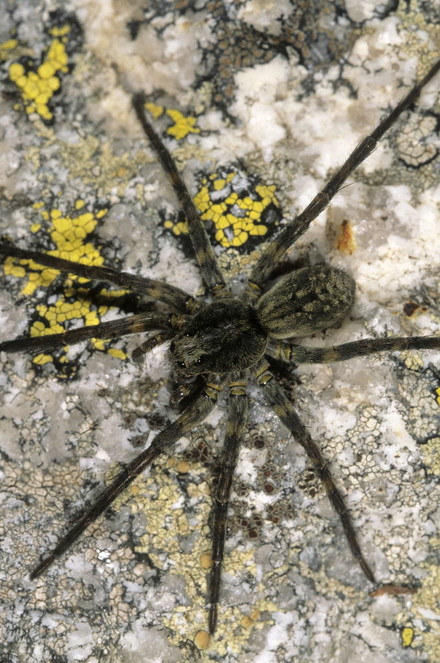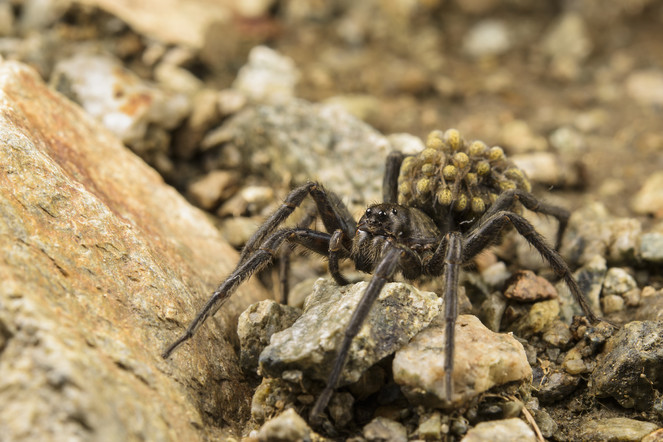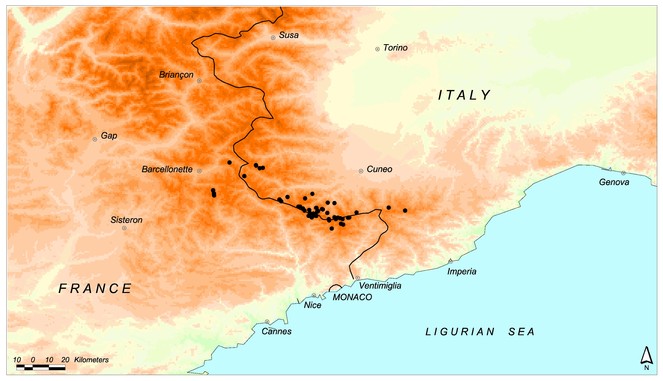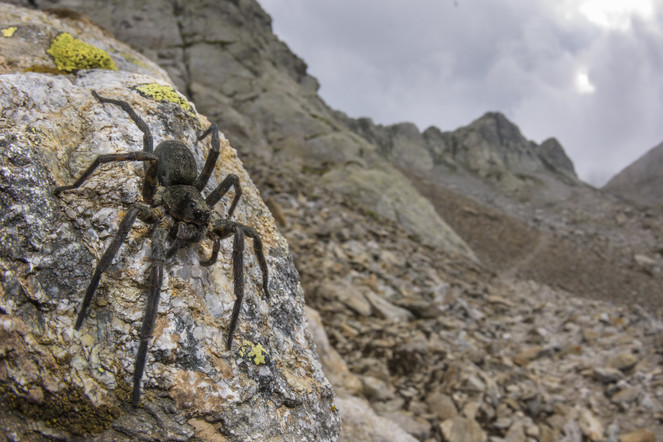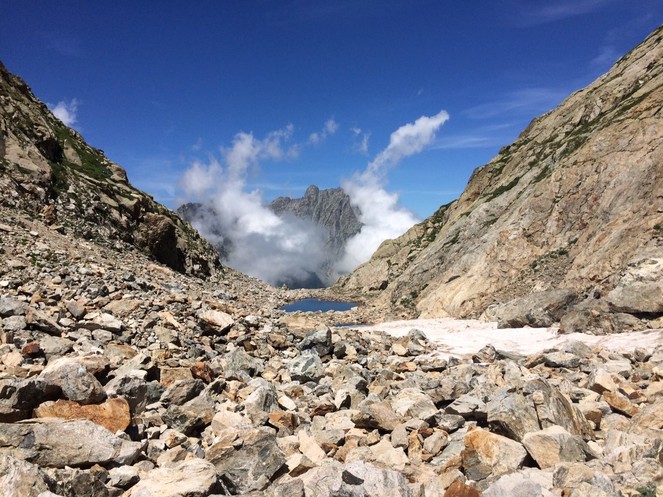|
Biodiversity Data Journal : Species Conservation Profile
|
|
Corresponding author: Stefano Mammola (stefano.mammola@unito.it), Marco Isaia (marco.isaia@unito.it)
Academic editor: Pavel Stoev
Received: 16 Sep 2016 | Accepted: 04 Oct 2016 | Published: 07 Oct 2016
© 2016 Stefano Mammola, Filippo Milano, Pedro Cardoso, Marco Isaia.
This is an open access article distributed under the terms of the Creative Commons Attribution License (CC BY 4.0), which permits unrestricted use, distribution, and reproduction in any medium, provided the original author and source are credited.
Citation: Mammola S, Milano F, Cardoso P, Isaia M (2016) Species conservation profile of the alpine stenoendemic spider Vesubia jugorum(Araneae, Lycosidae) from the Maritime Alps. Biodiversity Data Journal 4: e10527. doi: 10.3897/BDJ.4.e10527
|

|
Abstract
Vesubia jugorum (Simon, 1881) (Araneae: Lycosidae) is a large-sized wolf spider that occurs in alpine rocky areas above 2,000 m altitude. The species is stenoendemic, with a limited number of populations documented in the literature from the Maritime Alps (Italy, France). Due to the climate change, the current observed extent of occurrence (EEO 4,412 km2) and the area of occupancy (AOO 835 km2) are declining.
Keywords
Climate Change, wolf spider, high altitudes, IUCN, red list
Contributors
François Breton, Christine Rollard, Christophe Hervé, Emanuele Biggi, Federico Crovetto, Raquel Galindo, Irene Frigo, Liliana Milano, Mariagrazia Morando, Mauro Paschetta, Edoardo Ricca, Elena Piano and Davide Giuliano contributed with occurrence data.
Species information
Common names
Giant alpine spider (English)
Taxonomy
| Kingdom | Phylum | Class | Order | Family |
|---|---|---|---|---|
| Animalia | Arthropoda | Arachnida | Araneae | Lycosidae |
Taxonomic notes
Vesubia jugorum is a large-sized spider (body length: 15–20 mm, prosoma: 7-9 mm). The prosoma is generally blackish or dark brown, marked with black streaks irradiating from the fovea. The opisthosoma is dark grey dorsally and brown reddish ventrally. Legs are dark brown dorsally and reddish-yellowish ventrally, especially on coxae (Figs
- Global
Geographic range
- Palearctic
- France
- Italy
Suppl. material
Basis (narrative)
We based the Species Distribution Model (SDM) on literature data (
Occurrences were used to model the current distribution of the species through a MaxEnt model in dismo R package (
To estimate the potential variation of the EOO and AOO due to future climate change, the model was projected in the future (year 2028; i.e. 3 spider generations) according to two different representative concentration pathways, namely rcp 2.6 (low emission rate) and rcp 8.5 (high emission rate).
Range description
Vesubia jugorum was originally described from an unspecified locality at high altitude in the vicinity of St. Martin-Vésubie (Haute Vésubie Valley, France). The range of this stenoendemic species is centered on the Maritime Alps (43 records). Two additional subpopulations occur at the eastern and north-western corners of the range, in Ligurian (2 records) and Cottian Alps (2 records). Most localities are situated in the Site of Community Importance and Special Area of Conservation IT1160056 “Alpi Marittime” (NW Italy).
New occurences
-
scientificName: Vesubia jugorum; family:Lycosidae; taxonRank:species; scientificNameAuthorship:(Simon, 1881); continent:Europe; country:France; stateProvince:Alpes-Maritimes; municipality:Uvernet Fours; locality:Col des Esbéliousses; verbatimElevation:2500; minimumElevationInMeters:2500; maximumElevationInMeters:2500; decimalLatitude:44.28240; decimalLongitude:6.71840; georeferenceProtocol:GPS; samplingProtocol:hand collecting; eventDate:23 Jul 2006; habitat:Rocky areas; individualCount:1; sex:female; lifeStage:adult; recordedBy:Breton, Braud; identifiedBy:Herve; dateIdentified:2006; basisOfRecord:PreservedSpecimen
-
scientificName: Vesubia jugorum; family:Lycosidae; taxonRank:species; scientificNameAuthorship:(Simon, 1881); continent:Europe; country:France; stateProvince:Alpes-Maritimes; municipality:Uvernet Fours; locality:Le Trou de l'Aigle; verbatimElevation:2748; minimumElevationInMeters:2748; maximumElevationInMeters:2748; decimalLatitude:44.26490; decimalLongitude:6.72290; georeferenceProtocol:GPS; samplingProtocol:hand collecting; eventDate:20 Aug 2006; habitat:Rocky areas; individualCount:1; sex:female; lifeStage:adult; recordedBy:Breton; identifiedBy:Isaia (Validated); dateIdentified:2016; basisOfRecord:Based on photographs
-
scientificName: Vesubia jugorum; family:Lycosidae; taxonRank:species; scientificNameAuthorship:(Simon, 1881); continent:Europe; country:France; stateProvince:Alpes-Maritimes; municipality:Meyronnes; locality:Les Courroies de David; verbatimElevation:2405; minimumElevationInMeters:2405; maximumElevationInMeters:2405; decimalLatitude:44.43750; decimalLongitude:6.80880; georeferenceProtocol:GPS; samplingProtocol:hand collecting; eventDate:25 Jun 2007; habitat:Rocky areas; individualCount:6; sex:female; lifeStage:adult; recordedBy:Breton; identifiedBy:Isaia (Validated); dateIdentified:2016; basisOfRecord:Based on photographs
-
scientificName: Vesubia jugorum; family:Lycosidae; taxonRank:species; scientificNameAuthorship:(Simon, 1881); continent:Europe; country:France; stateProvince:Alpes-Maritimes; municipality:Allos; locality:Lac de la Petite Cayolle; verbatimElevation:2600; minimumElevationInMeters:2600; maximumElevationInMeters:2600; decimalLatitude:44.25400; decimalLongitude:6.72370; georeferenceProtocol:GPS; samplingProtocol:hand collecting; eventDate:03 Aug 2007; habitat:Rocky areas; individualCount:1; sex:male; lifeStage:adult; recordedBy:Breton; identifiedBy:Isaia (Validated); dateIdentified:2016; basisOfRecord:Based on photographs
-
scientificName: Vesubia jugorum; family:Lycosidae; taxonRank:species; scientificNameAuthorship:(Simon, 1881); continent:Europe; country:Italy; stateProvince:Cuneo; municipality:Valdieri; locality:Passo di Préfouns; verbatimElevation:2395; minimumElevationInMeters:2395; maximumElevationInMeters:2395; decimalLatitude:44.16970; decimalLongitude:7.22490; georeferenceProtocol:GPS; samplingProtocol:vidit; eventDate:09 Aug 2011; habitat:Rocky areas; individualCount:5; sex:female; lifeStage:adult; recordedBy:Morando, Pala; identifiedBy:Isaia (Validated); dateIdentified:2016; basisOfRecord:Based on photographs
-
scientificName: Vesubia jugorum; family:Lycosidae; taxonRank:species; scientificNameAuthorship:(Simon, 1881); continent:Europe; country:Italy; stateProvince:Cuneo; municipality:Entracque; locality:Sentiero Pagarì; verbatimElevation:2500; minimumElevationInMeters:2500; maximumElevationInMeters:2500; decimalLatitude:44.13050; decimalLongitude:7.41020; georeferenceProtocol:GPS; samplingProtocol:vidit; eventDate:17 Aug 2011; habitat:Rocky areas; individualCount:1; sex:female; lifeStage:adult; recordedBy:Giordano, Dalmasso; identifiedBy:Isaia (Validated); dateIdentified:2016; basisOfRecord:Based on photographs
-
scientificName: Vesubia jugorum; family:Lycosidae; taxonRank:species; scientificNameAuthorship:(Simon, 1881); continent:Europe; country:France; stateProvince:Alpes-Maritimes; municipality:Saint-Martin-Vesubie; locality:Lake Mercantour; verbatimElevation:2600; minimumElevationInMeters:2600; maximumElevationInMeters:2600; decimalLatitude:44.14031; decimalLongitude:7.29012; georeferenceProtocol:GPS; samplingProtocol:vidit; eventDate:02 Aug 2011; habitat:Rocky areas; individualCount:1; sex:female; lifeStage:adult; recordedBy:Piacenza; identifiedBy:Isaia (Validated); dateIdentified:2016; basisOfRecord:Based on photographs
-
scientificName: Vesubia jugorum; family:Lycosidae; taxonRank:species; scientificNameAuthorship:(Simon, 1881); continent:Europe; country:Italy; stateProvince:Cuneo; municipality:Valdieri; locality:Bivio Lago Nasta; verbatimElevation:2792; minimumElevationInMeters:2792; maximumElevationInMeters:2792; decimalLatitude:44.16750; decimalLongitude:7.30020; georeferenceProtocol:GPS; samplingProtocol:vidit; eventDate:30 Aug 2011; habitat:Rocky areas; individualCount:1; sex:female; lifeStage:adult; recordedBy:Morando, Pala; identifiedBy:Isaia (Validated); dateIdentified:2016; basisOfRecord:Based on photographs
-
scientificName: Vesubia jugorum; family:Lycosidae; taxonRank:species; scientificNameAuthorship:(Simon, 1881); continent:Europe; country:Italy; stateProvince:Cuneo; municipality:Valdieri; locality:Colle di Ciriegia; verbatimElevation:2543; minimumElevationInMeters:2543; maximumElevationInMeters:2543; decimalLatitude:44.14183; decimalLongitude:7.28315; georeferenceProtocol:GPS; samplingProtocol:hand collecting; eventDate:24 Jun 2016; habitat:Rocky areas; individualCount:6; sex:female; lifeStage:adult; recordedBy:Isaia, Mammola; identifiedBy:Isaia; dateIdentified:2016; basisOfRecord:PreservedSpecimen
-
scientificName: Vesubia jugorum; family:Lycosidae; taxonRank:species; scientificNameAuthorship:(Simon, 1881); continent:Europe; country:Italy; stateProvince:Cuneo; municipality:Valdieri; locality:Vallone di Ciriegia; verbatimElevation:2265; minimumElevationInMeters:2265; maximumElevationInMeters:2265; decimalLatitude:44.14887; decimalLongitude:7.27741; georeferenceProtocol:GPS; samplingProtocol:hand collecting; eventDate:24 Jun 2016; habitat:Rocky areas; individualCount:3; sex:female; lifeStage:juvenile, adult; recordedBy:Isaia, Mammola; identifiedBy:Isaia; dateIdentified:2016; basisOfRecord:PreservedSpecimen
-
scientificName: Vesubia jugorum; family:Lycosidae; taxonRank:species; scientificNameAuthorship:(Simon, 1881); continent:Europe; country:Italy; stateProvince:Cuneo; municipality:Valdieri; locality:Pian della Casa; verbatimElevation:2037; minimumElevationInMeters:2037; maximumElevationInMeters:2037; decimalLatitude:44.15387; decimalLongitude:7.27433; georeferenceProtocol:GPS; samplingProtocol:hand collecting; eventDate:24 Jun 2016; habitat:Rocky areas; individualCount:1; sex:female; lifeStage:adult; recordedBy:Isaia, Mammola; identifiedBy:Isaia; dateIdentified:2016; basisOfRecord:PreservedSpecimen
-
scientificName: Vesubia jugorum; family:Lycosidae; taxonRank:species; scientificNameAuthorship:(Simon, 1881); continent:Europe; country:Italy; stateProvince:Cuneo; municipality:Entracque; locality:Bivacco Moncalieri; verbatimElevation:2710; minimumElevationInMeters:2710; maximumElevationInMeters:2710; decimalLatitude:44.13331; decimalLongitude:7.39079; georeferenceProtocol:GPS; samplingProtocol:vidit; eventDate:23 Aug 2011; habitat:Rocky areas; individualCount:1; sex:female; lifeStage:adult; recordedBy:Morando; identifiedBy:Isaia (Validated); dateIdentified:2016; basisOfRecord:Based on photographs
-
scientificName: Vesubia jugorum; family:Lycosidae; taxonRank:species; scientificNameAuthorship:(Simon, 1881); continent:Europe; country:Italy; stateProvince:Cuneo; municipality:Vinadio; locality:Alpine scree near Colle della Lombarda; verbatimElevation:2342; minimumElevationInMeters:2342; maximumElevationInMeters:2342; decimalLatitude:44.21163; decimalLongitude:7.39079; georeferenceProtocol:GPS; samplingProtocol:vidit; eventDate:20 Jul 2016; habitat:Rocky areas; individualCount:1; sex:female; lifeStage:adult; recordedBy:Mammola; identifiedBy:Mammola (Validated); dateIdentified:2016; basisOfRecord:Based on photographs
-
scientificName: Vesubia jugorum; family:Lycosidae; taxonRank:species; scientificNameAuthorship:(Simon, 1881); continent:Europe; country:Italy; stateProvince:Cuneo; municipality:Acceglio; locality:Passo dell'Escalon; verbatimElevation:2939; minimumElevationInMeters:2939; maximumElevationInMeters:2939; decimalLatitude:44.42262; decimalLongitude:6.95581; georeferenceProtocol:GPS; samplingProtocol:hand collecting; eventDate:25 Aug 2016; habitat:Rocky areas; individualCount:2; sex:female; lifeStage:adult; recordedBy:Isaia, Mammola; identifiedBy:Isaia; dateIdentified:2016; basisOfRecord:PreservedSpecimen
-
scientificName: Vesubia jugorum; family:Lycosidae; taxonRank:species; scientificNameAuthorship:(Simon, 1881); continent:Europe; country:Italy; stateProvince:Cuneo; municipality:Canosio; locality:Passo della Gardetta; verbatimElevation:2568; minimumElevationInMeters:2568; maximumElevationInMeters:2568; decimalLatitude:44.40713; decimalLongitude:6.99455; georeferenceProtocol:GPS; samplingProtocol:hand collecting; eventDate:25 Aug 2016; habitat:Rocky areas; individualCount:1; sex:female; lifeStage:adult; recordedBy:Isaia, Mammola; identifiedBy:Isaia; dateIdentified:2016; basisOfRecord:PreservedSpecimen
-
scientificName: Vesubia jugorum; family:Lycosidae; taxonRank:species; scientificNameAuthorship:(Simon, 1881); continent:Europe; country:Italy; stateProvince:Cuneo; municipality:Acceglio; locality:Oserot; verbatimElevation:2508; minimumElevationInMeters:2508; maximumElevationInMeters:2508; decimalLatitude:44.40522; decimalLongitude:6.97708; georeferenceProtocol:GPS; samplingProtocol:hand collecting; eventDate:25 Aug 2016; habitat:Rocky areas; individualCount:1; sex:female; lifeStage:adult; recordedBy:Isaia, Mammola; identifiedBy:Isaia; dateIdentified:2016; basisOfRecord:PreservedSpecimen
-
scientificName: Vesubia jugorum; family:Lycosidae; taxonRank:species; scientificNameAuthorship:(Simon, 1881); continent:Europe; country:Italy; stateProvince:Cuneo; municipality:Argentera; locality:Rocca dei Tre Vescovi; verbatimElevation:2628; minimumElevationInMeters:2628; maximumElevationInMeters:2628; decimalLatitude:44.36185; decimalLongitude:6.89117; georeferenceProtocol:GPS; samplingProtocol:hand collecting; eventDate:19 Aug 2016; habitat:Rocky areas; individualCount:2; sex:female; lifeStage:adult; recordedBy:Isaia, Mammola, Biggi, Galindo; identifiedBy:Isaia; dateIdentified:2016; basisOfRecord:PreservedSpecimen
-
scientificName: Vesubia jugorum; family:Lycosidae; taxonRank:species; scientificNameAuthorship:(Simon, 1881); continent:Europe; country:Italy; stateProvince:Cuneo; municipality:Entracque; locality:Vallone del Chiapous; verbatimElevation:2324; minimumElevationInMeters:2324; maximumElevationInMeters:2324; decimalLatitude:44.17833; decimalLongitude:7.32277; georeferenceProtocol:GPS; samplingProtocol:hand collecting; eventDate:06 Aug 2016; habitat:Rocky areas; individualCount:5; sex:male, female; lifeStage:adult; recordedBy:Milano; identifiedBy:Isaia; dateIdentified:2016; basisOfRecord:PreservedSpecimen
-
scientificName: Vesubia jugorum; family:Lycosidae; taxonRank:species; scientificNameAuthorship:(Simon, 1881); continent:Europe; country:Italy; stateProvince:Cuneo; municipality:Vinadio; locality:Passo Tesina; verbatimElevation:2450; minimumElevationInMeters:2450; maximumElevationInMeters:2450; decimalLatitude:44.23121; decimalLongitude:7.08665; georeferenceProtocol:GPS; samplingProtocol:hand collecting; eventDate:20 Jul 2016; habitat:Rocky areas; individualCount:5; sex:male, female; lifeStage:adult; recordedBy:Isaia, Mammola, Milano; identifiedBy:Isaia; dateIdentified:2016; basisOfRecord:PreservedSpecimen
-
scientificName: Vesubia jugorum; family:Lycosidae; taxonRank:species; scientificNameAuthorship:(Simon, 1881); continent:Europe; country:Italy; stateProvince:Cuneo; municipality:Vinadio; locality:Passo di Sant'Anna; verbatimElevation:2397; minimumElevationInMeters:2397; maximumElevationInMeters:2397; decimalLatitude:44.22240; decimalLongitude:7.09513; georeferenceProtocol:GPS; samplingProtocol:hand collecting; eventDate:20 Jul 2016; habitat:Rocky areas; individualCount:5; sex:female; lifeStage:adult; recordedBy:Isaia, Mammola, Milano; identifiedBy:Isaia; dateIdentified:2016; basisOfRecord:PreservedSpecimen
-
scientificName: Vesubia jugorum; family:Lycosidae; taxonRank:species; scientificNameAuthorship:(Simon, 1881); continent:Europe; country:Italy; stateProvince:Cuneo; municipality:Valdieri; locality:Rifugio Bozano; verbatimElevation:2390; minimumElevationInMeters:2390; maximumElevationInMeters:2390; decimalLatitude:44.18480; decimalLongitude:7.29145; georeferenceProtocol:GPS; samplingProtocol:hand collecting; eventDate:01 Aug 2016; habitat:Rocky areas; individualCount:4; sex:male, female; lifeStage:adult; recordedBy:Milano; identifiedBy:Isaia; dateIdentified:2016; basisOfRecord:PreservedSpecimen
-
scientificName: Vesubia jugorum; family:Lycosidae; taxonRank:species; scientificNameAuthorship:(Simon, 1881); continent:Europe; country:Italy; stateProvince:Cuneo; municipality:Chiusa Pesio; locality:Canale dei Torinesi (Monte Marguareis); verbatimElevation:2160; minimumElevationInMeters:2160; maximumElevationInMeters:2160; decimalLatitude:44.17671; decimalLongitude:7.69461; georeferenceProtocol:GPS; samplingProtocol:hand collecting; eventDate:21 Aug 2016; individualCount:4; sex:male, female; lifeStage:adult; recordedBy:Isaia, Galindo; identifiedBy:Isaia; dateIdentified:2016; basisOfRecord:PreservedSpecimen
Extent of occurrence
Justification for trend
The species inhabits rocky areas of the subnival and nival zones of the Maritime Alps. The high altitude regions are particularly vulnerable to climatic variations due to climate change, with warming rates approximately doubling the global average (
Area of occupancy
Justification for trend
Future forecasts based on different emission scenarios show a significant reduction in the bioclimatic range of Vesubia jugorum (details in
Locations
Justification for number of locations
The whole population is affected by the ongoing climate change.
Population
Justification for trend
Inferred from the decline in AOO.
Subpopulations
Justification for trend
The main subpopulation of the species is centred in Maritime Alps. This core area includes over 90% of the known localities. Two additional subpopulations are identified at the north-western and eastern corners of the distribution range, corresponding to the Southern Cottian and Ligurian Alps, respectively. All future warming scenarios predict the extinction of the latter subpopulation.
Justification for fragmentation
Within the core area the suitable habitat is roughly continuous, with peaks and rocky areas ensuring connectivity between local populations. However, unsuitable habitat —namely grasslands at lower altitudes— reduces connectivity between subpopulations.
Habitat
Habitat (narrative)
The species is restricted to alpine rocky areas above 2,000 m. These include rocky debris, boulder fields, and alpine screes (Figs
Typical rocky areas inhabited by Vesubia jugorum — Maritime Alps, Province of Cuneo. [Photo credit: Emanuele Biggi, 2016]
Justification for trend
The optimal habitat for the species is not expected to undergo significant variations in the future, as touristic pressure is negligible in the high mountain peaks of the Maritime Alps. Altitudinal shifts of vegetation due to climate change may hypothetically affect the extension of the subnival zone determining small variations in the extent of high altitude rocky areas.
- 6. Rocky areas (e.g. inland cliffs, mountain peaks)
Ecology
Ecology and traits (narrative)
The species is active during the warm season, from the snow melting in late June to mid September. Males are mainly found from July to August, whereas females and immatures can be found throughout the whole season. During the day, individuals can be observed wandering on the rocks. Females with cocoons build retreats under stones (see illustration in
Threats
Threats
- 11. Climate change & severe weather
- 11.1. Climate change & severe weather - Habitat shifting & alteration
- 11.3. Climate change & severe weather - Temperature extremes
Conservation
Conservation actions
- 1.1. Land/water protection - Site/area protection
- 3. Species management
- 3.3. Species management - Species re-introduction
- 3.4. Species management - Ex-situ conservation
- 4. Education & awareness
Justification for conservation actions
Most of the species range falls within the borders of national parks, sites of community importance and special protection areas, namely Parco Naturale Alpi Marittime (Italy), Parco Naturale del Marguareis (Italy) and Parc National du Mercantour (France).
In the light of the existing threats, it is expected that the survival of the species will depend on monitoring, conservation management and translocation programmes. Ex-situ conservation should also be considered, to ensure the preservation of healthy individuals for re-introduction in suitable habitats situated to the north from the current distribution area.
Other
- 1. Research
- 1.2. Research - Population size, distribution & trends
- 1.3. Research - Life history & ecology
- 2. Conservation Planning
- 2.1. Conservation Planning - Species Action/Recovery Plan
- 3. Monitoring
- 3.1. Monitoring - Population trends
Acknowledgements
We are indebted to Wolfgang Nentwig for the helpful discussion about the life history of wolf spiders. Our thanks also go to Pavel Stoev, Gergin Blagoev, Wolfgang Nentwig and Christo Deltshev for their useful comments during the review process. We are greatful to Mattia, Adriana and Guido Colombo for providing logistic support at Rifugio Garelli, and to Emanuele Biggi for the photographs of Vesubia and its habitat. We also acknowledge the help of Luca Giraudo and the staff of Parco Naturale Alpi Marittime.
References
-
Impacts of climate change on the future of biodiversity.Ecology Letters15(4):365‑377. DOI: 10.1111/j.1461-0248.2011.01736.x
-
Regional temperature variability in the European Alps: 1760-1998 from homogenized instrumental time series.International Journal of Climatology21(14):1779‑1801. DOI: 10.1002/joc.689
-
red: IUCN Redlisting Tools.0.1.0..R. URL: http://CRAN.R-project.org/package=red
-
dismo: Species distribution modeling.1.0-5.R. URL: http://CRAN.R-project.org/package=dismo
-
Threatening the giant: the response of Vesubia jugorum (Araneae, Lycosidae) to climate change. In: Cushing P (Ed.)Program and Abstracts.20th Congress of Arachnology,Golden, Colorado, USA,July 2-9, 2016.Denver Museum of Nature & Science Reports,3,230pp. [InEnglish]. URL: www.dmns.org
-
Annotated checklist of the spiders (Arachnida, Araneae) of the Site of Community Importance and Special Area of Conservation “Alpi Marittime” (NW Italy).Zoosystema37(1):57‑114. DOI: 10.5252/z2015n1a4
-
Catalogo ragionato dei ragni (Arachnida, Araneae) del Piemonte e della Lombardia.Memorie dell’Associazione Naturalistica Piemontese9:1‑161. [InItalian].
-
Alpine endemic spiders shed light on the origin and evolution of subterranean species.PeerJ3:e1384. DOI: 10.7717/peerj.1384
-
Über bemerkenswerte Spinnen des Parc National du Mercantour (F) und seiner Umgebung (Arachnida: Araneae).Revue Suisse de Zoologie95:329‑353. [InGerman]. DOI: 10.5962/bhl.part.79655
-
Spiders of Europe. www.araneae.unibe.ch. Accession date: 2016 7 05.
-
Arachnides nouveaux ou rares de la faune française.Bulletin de la Société Zoologique de France6:82‑91. [InFrench].
-
Su alcuni ragni italiani della famiglia Lycosidae.Memorie del Museo di Storia Naturale di Verona16:107‑112. [InItalian].
-
Vesubia jugorum (Simon) un ragno licoside endemico delle Alpi Marittime.Atti della Società Toscana di Scienze Naturali75(B):255‑264. [InItalian].
Supplementary material
Download file (851.00 bytes)
